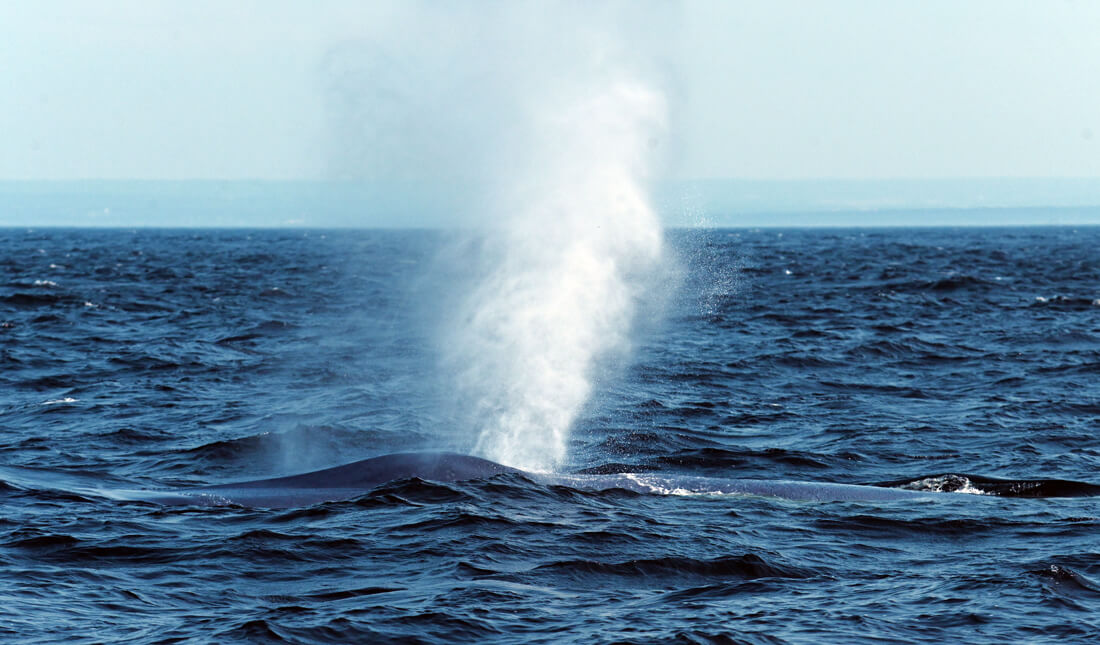The fog lifts after having shrouded Gaspé Bay for several days, meaning observers can finally admire the colourful panorama… and find cetaceans more quickly! In the estuary, bluish reflections are caused not only by the river and the sky, but also by the appearance of the season’s first blue whale.
The individual was able to be identified as B236, a.k.a. Galinule. This is not this male’s first visit to the St. Lawrence: the first photos taken by the Group for Research and Education on Marine Mammals (GREMM) date back to August 31, 1990! Thirty-three years later, his arrival in the Saguenay-St. Lawrence Marine Park sector is still very well received. Following this thrilling observation, naturalist and wildlife photographer Renaud Pintiaux writes: “On Monday, happiness was the colour blue. I was able to observe a blue whale from shore in Les Bergeronnes. The individual showed its caudal fin when it dove. The same day, we observe from aboard a boat a blue whale that did not show its tail. Whether this was the same individual or a different one, we may never know. In any case, it was a sight to behold…”
The diversity of the estuary is always surprising, as testified by last week’s sightings: a fin whale, humpbacks, minke whales, harbour porpoises, belugas, grey and harbour seals. Beyond simple checklists of species, the beauty and magic of the place seem to stem from this fragile mix between the sense of wonder triggered by the sightings and the presence of wildlife that returns every summer. A repeatedly breaching humpback whale was admired from Les Bergeronnes, porpoises were seen swimming up the Saguenay Fjord, and seals were resting quietly on their favourite rocks.
The GREMM research team has also kicked off its season of field work on belugas. Several of these white whales were seen swimming near Île Rouge, Batture aux Alouettes and in the Saguenay. Two new humpback whales also visited the area: H929 and H007 a.k.a. Éline and Siam, respectively. This is hardly the latter’s first visit, as this male has been coming to the estuary since 1981. “A real living legend!” Remarks one marine mammal enthusiast.
Interruptions
“Oh!” “Ah!” “Wow!” everyone stands up at once, their eyes sparkling with excitement. What might have captivated the attention of the naturalists at the Marine Mammal Interpretation Centre during their team meeting on this beautiful Tuesday afternoon? A humpback whale near the coast!
Some of the more skeptical team members believe at first that it’s a minke whale, several of which have been seen in the past few days. Finally, the whale comes up for another breath and the ID is confirmed: it’s a humpback after all! “That close to shore is unheard of,” exclaims Patrice Corbeil, GREMM’s director of education, who is able to admire the entrance to the Saguenay every day from his office. Taking that little break was definitely worth it!
Watching and listening from shore
In Pointe-aux-Anglais, a local resident spotted a humpback on the horizon. A little farther east, in Franquelin, a fin whale lets out a loud blast. Although no humpbacks have been reported yet, the area has been teeming with harbour porpoises, minke whales and grey seals. In Pointe-des-Monts, just a single minke whale has been seen since the start of the season by one resident who is beginning to worry not only about the scarcity of whales, but also about the poor catches in the area’s fisheries. To be continued as the season progresses!
In Magpie, it’s pinnipeds that are attracting attention: “Already observed here in Les Cayes de la Rivière Magpie [Translator’s note: a chain of islets near the town of Magpie], which seems to be a place where the seals like to rest. On July 16, there were about thirty harbour seals!”
In the gulf
Harbour porpoises have been present in large numbers in the Mingan Island region, where a dozen or so minke whales were also tallied, while a fin whale was spotted west of Anticosti Island.
In the Gaspé Peninsula, sharks are practically stealing the spotlight from marine mammals, with a basking shark spotted quite close to the coast. A great white shark has also made an appearance, passing from Cap-des-Rosiers to Gaspé and then onward to the Magdalen Islands before doing a U-turn and heading back toward Percé. Nicknamed “Jekyll,” this individual is being tracked using a satellite tag. Despite its reputation, swimmers and bathers don’t have too much to worry about! That’s because this species’ favourite prey is seals. That said, they would be well advised not to go seeking their thrills amongst a group of seals…
“After two weeks in the fog, we can finally see the horizon again! exclaims a captain of a tour boat in Gaspé Bay. “I don’t even know how we managed to find whales before,” he adds. However, these conditions didn’t prevent them from observing between one and eight humpbacks and between one and three fin whales per day. Minke whales, on the other hand, have been gorging themselves near the coast. Harbour porpoises have been present in record numbers, while seals can always be seen. If such a wide diversity could be seen through the fog patches, what will we be able to observe now that the horizon is clear?
Where are the whales this week? Observations map
These infomations were reported by our network of observers. They give an idea of the presence of whales and in no way represent the actual distribution of whales in the St. Lawrence river. Simply use it for fun!
Click on the whale or seal icons to discover the species, the number of individuals, additional information or photos of the sighting. To enlarge the map, click on the icon in the top right-hand corner. The map works well on Chrome and Firefox, but not so well on Safari.
To display the list of sightings, click on the icon in the top left-hand corner.










